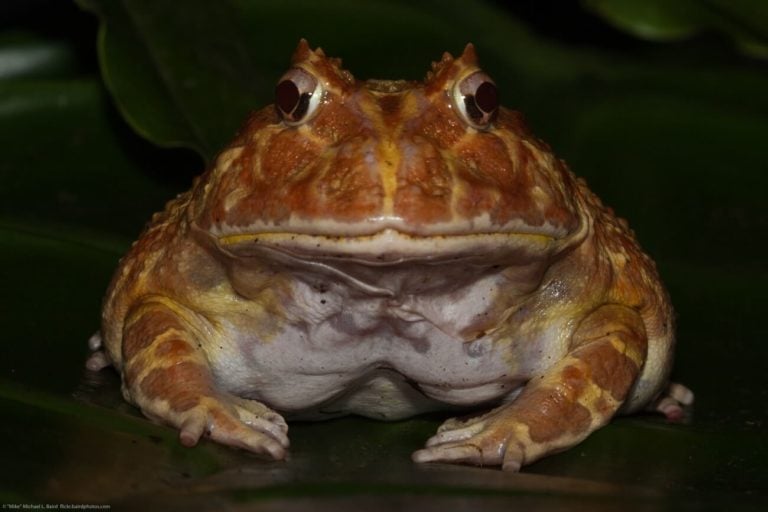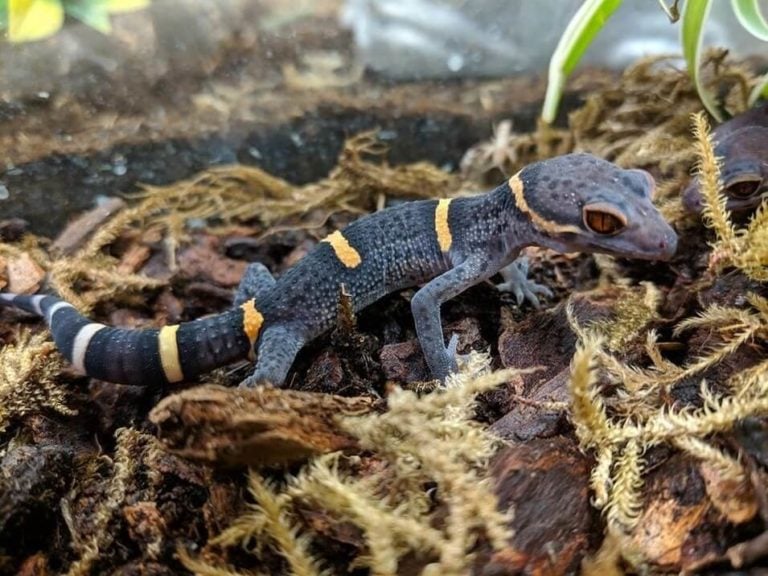The Hermann’s tortoise is a great pet reptile that not enough people consider. When you compare them to a more popular species (like the Russian Tortoise), it seems like they hardly get any attention at all!
But there’s a lot to like about the Hermann’s tortoise, and we find ourselves recommending them all the time. These tortoises are beautiful, fairly low-maintenance, and fun to observe.
This guide will teach you the essentials when it comes to Hermann’s tortoise care. It covers diet, habitat setup, size, lifespan, and more!
Table of Contents
Species Summary
Named after the famed French naturalist, Johann Herman, the Hermann’s tortoise (Testudo hermanni) is a beautiful reptile with a calm demeanor. Known for its passive and gentle nature, these tortoises make wonderful lifelong pets.
Hermann’s tortoises are native to the European side of the Mediterranean Sea. The population is split up into two subspecies. The distribution of Eastern Hermann’s tortoises stretches from Eastern Italy to Western Turkey. Meanwhile, Western Hermann’s tortoises are found throughout Spain, France, and surrounding areas.
Expert Tip: Both subspecies are popular within the reptile trade. While they differ in size, both share similar needs.
Raising a Hermann’s tortoise requires a lot of dedication. However, the payoff is well worth the hard work. With the right care, you can enjoy the beauty of these reptiles for decades to come!
Hermann’s Tortoise Size
The average Hermann’s tortoise size actually varies based on the subspecies. The most common subspecies, the Western Hermann’s tortoise, is the smallest.
This species has an average adult size of six to eight inches. Meanwhile, the Eastern subspecies reaches a full size of about 11 inches.
Lifespan
With proper care, the typical Hermann’s tortoise lifespan can reach up to 75 years! However. there’s still quite a lot of variance when it comes to their exact life expectancy.
Some sources say that these reptiles can live up to 100 years! Meanwhile, some owners have to say goodbye to their tortoise after 30 years.
Expert Care: Helping your tortoise reach the upper limits of their lifespan requires optimal care. These reptiles depend on top-notch husbandry to stay healthy. Like any other reptile, these tortoises are susceptible to disease, stress, and premature death when their needs aren’t being met.
Appearance & Colors
The Hermann’s tortoise is a beautiful species. Their carapace is tall and rounded. The individual scutes are quite large compared to other species.
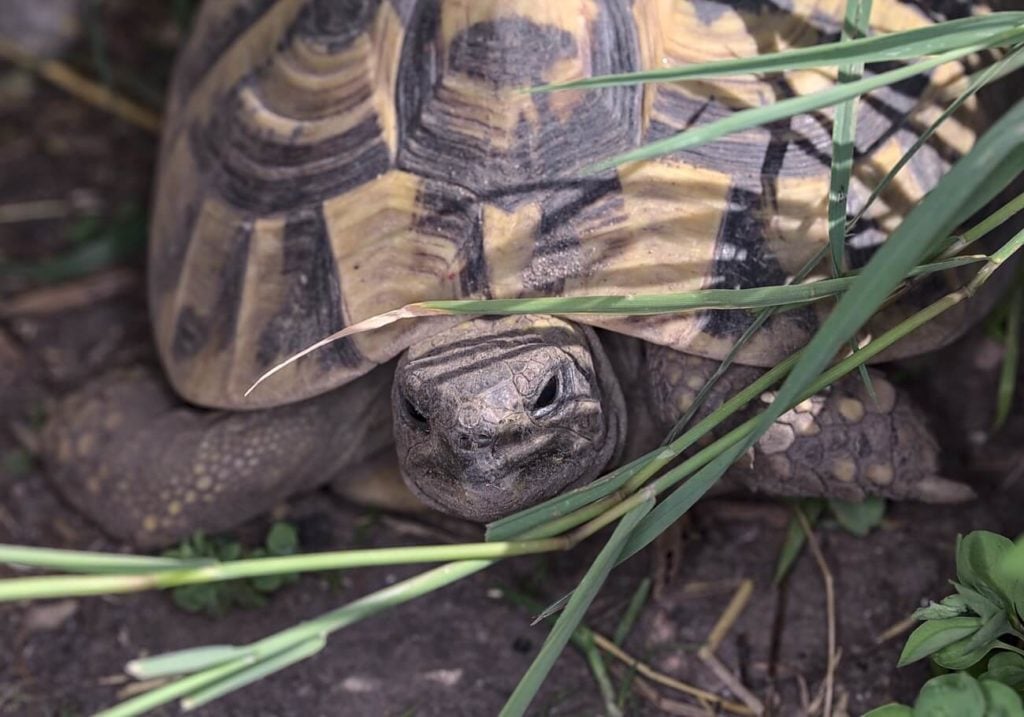
The shell usually has a base color of dark brown, olive green, or black. Accents of bright yellow create an interesting pattern on their shells. The pattern is not uniform, so every scute is unique.
The underside of the shell (known as the plastron) has two dark bands on both sides of the seam. In some tortoises, the bands are thick and connected. For others, they may be broken up a bit by the same yellow color on the carapace.
The head of the Hermann’s tortoise is typically dark brown and features hard scales for protection. More intense scales are found on the legs.
The legs of the tortoise are thick and muscular. The hind legs tend to have more strength than the front ones, leading to some differences in size. However, all of their feet have five claws to help them navigate their environment and burrow.
Differences between male and female Hermann’s tortoises are subtle. Males have longer tails with a well-developed spur. However, females tend to be slightly larger in general.
Hermann’s Tortoise Care
Proper Hermann’s tortoise care is all about replicating the habitat and lifestyle these reptiles are used to in the wild.
Don’t be discouraged if it takes some time to get things right. Caring for these tortoises can be a very rewarding experience, and actually fairly low-maintenance once you have their bases covered.
To help you with your tortoise-raising endeavors, here are some care guidelines you need to know.
Enclosure Size
Let’s start with the enclosure. Hermann’s tortoises need a sizable habitat to reach their full potential.
You have a couple of options here:
If you live in a warm climate, it’s best to keep the tortoise outside (if you have enough space). These reptiles do best in outdoor enclosures. Not only are outdoor spaces bigger, but it’s easier to replicate natural conditions.
Outdoor enclosures should be fully fenced-in with solid material, such as concrete or brick. The walls need to be a minimum of 18 inches high. Hermann’s tortoises aren’t big on climbing, but they do enjoy digging.
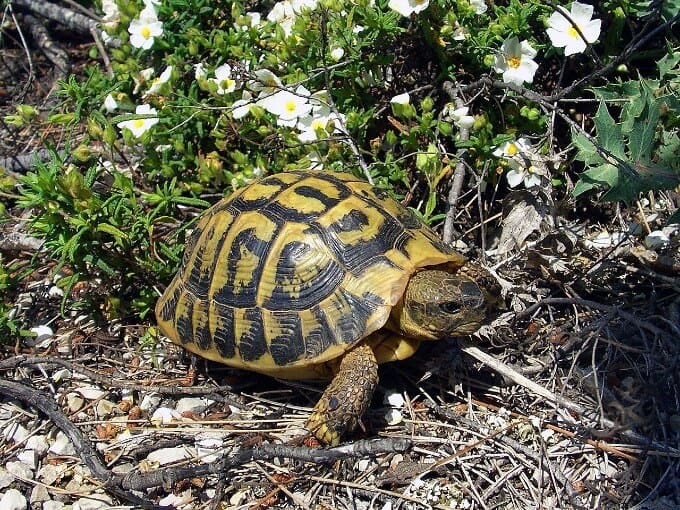
Because of this, you’ll need to extend the walls a couple of feet into the soil. This will prevent the tortoise from burrowing out.
If you live in a cooler area, keeping these reptiles inside is a fine option as well.
For an inside enclosure, choose a wooden vivarium. The vivarium should measure at least 48 inches long by about 24 inches deep. Height isn’t a huge factor, but there should be ample headroom.
Recommended Habitat Setup
In the wild, the Hermann’s tortoise spends most of its life on rocky hillsides and evergreen forests. For the best results, replicate this environment as closely as possible.
Outside, natural soil will do just fine for the base of the enclosure. In a vivarium, you’ll need to use a dry substrate that doesn’t affect humidity levels too much. A mixture of soil, sand, and cypress bark is best.
Expert Tip: Create a layer of substrate that’s at least two inches thick for digging. Anything less will be too shallow.
Next, you’ll want to add plenty of rocks and plants. Outside, you can use plants that are native to your region.
For indoor enclosures, you can get creative and use plants that come from arid regions. Both artificial and live plants work fine.
Finally, these tortoises need a hide box. This is particularly important for reptiles living outside. The box will provide shelter from the sun and inclement weather.
Provide a box that’s large enough for the tortoise to fit their entire body into comfortably.
Temperature & Lighting
Hermann’s tortoises have a general temperature tolerance between 60°F and 86°F.
Daytime temperatures should hover between 80°F and 86°F while nighttime temperatures can be in the neighborhood of 60°F to 65°F.
In an outdoor environment, it’s best to create an open spot where the tortoise can get full exposure to the sun. The tortoises will bask to regulate their temperature.
Because there is no natural sunlight in a vivarium, you must create a temperature gradient. Using a basking lamp, raise temperatures on one side of the habitat to 90 to 95 degrees. The cool side should be closer to 80 degrees.
Expert Tip: If temperatures get colder than 60 degrees at night in your area, use a heat emitter or under-tank heater to ensure that the enclosure stays within an acceptable range. The lights should stay off at night, as these reptiles require a standard day and night cycle.
Hermann’s tortoises kept indoors will also need UVB lights. UVB bulbs provide UVB rays as the sun would. Without that UVB exposure, your tortoise can experience severe bone and development problems. More on that later.
Let the UVB lamp shine on most of the enclosure. Keep it on during daylight hours. Make sure to replace it every six months or so as well.
Humidity
In most cases, you won’t have to worry about humidity levels with the Hermann’s tortoise. They don’t require ultra-humid environments like some other reptiles.
These tortoises need at least 25 percent humidity, which is easy to meet in both outdoor and indoor environments. Try to keep humidity levels under 70 percent to avoid potential respiratory infections too.
Even though this is a generous range, it’s always smart to invest in a high-quality hygrometer. You want to make sure the information you have is accurate before you make any changes!
Water
Whether you’re keeping your tortoise indoors or out, access to fresh water is a must. Secure a shallow pan in the habitat and keep it filled with clean water at all times.
The tortoise will drink from the pan. Sometimes, they’ll use it to soak and cool down. Because of this, the pan should be big enough for the tortoise to climb in.
Expert Tip: Be sure the pan or bowl you use is stable to prevent tipping. A flooded habitat can be a pain to clean up!
It’s a good idea to give your tortoise a simple soaking bath two or three times a week. The bath will help them stay hydrated.
Food & Diet
The perfect Hermann’s tortoise diet should consist of predominantly plant-based foods. In the wild, Hermann’s tortoises are plant foragers. They’ll roam their habitat and search for leafy greens or grasses to eat.
Here are some good food options to try out:
- Watercress
- Leafy lettuce
- Dandelion
- Cabbage
- Carrots
- Cauliflower
- Apples
- Parsley
- Bell Peppers
- Kale
- Clover
- Coriander
- Parsnip
- Broccoli
- Grasses and weeds
Create a healthy salad mixture using a variety of different foods to ensure that the tortoise is getting all the nutrients they need.
Hermann’s tortoises should be fed once a day. Aim for a food quantity that the tortoise can eat in 15 to 30 minutes.
For those reptiles living indoors, it’s good to provide some additional supplements as well. You can provide occasional worms dipped in calcium and vitamin supplements. Hermann’s tortoises can eat some insects and snails. However, their main diet should always consist of leafy greens and vegetables.
Potential Health Issues
Hermann’s tortoises aren’t immune to health issues. There are a few potential health concerns to watch out for. Some of the most common are respiratory infections and metabolic bone disease.
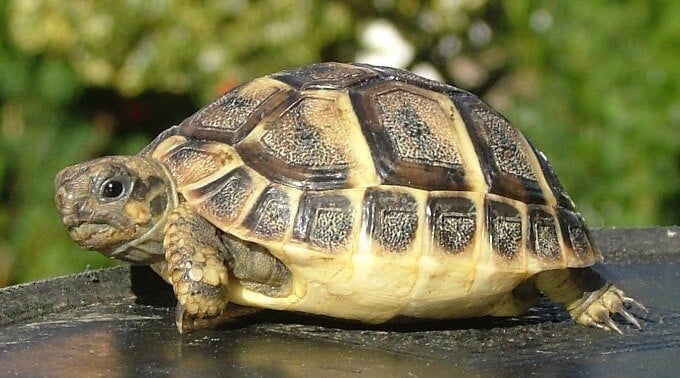
Respiratory infections can occur for a myriad of reasons. Oftentimes, the tortoises suffer from these infections when the humidity levels are too high. If that’s the case, increase ventilation to speed up moisture evaporation.
Infections can happen because of other environmental stressors as well. Unhygienic living conditions, dirty water, and even incorrect lighting can put the tortoise at risk.
Metabolic bone disease is a result of poor UVB exposure. These reptiles need exposure to UVB light to synthesize Vitamin D and metabolize calcium.
When they don’t have access to UVB light, the bones and carapace can become brittle. This puts the tortoise at severe risk for bone injuries. Younger tortoises can also experience developmental problems due to the lack of calcium in their bodies.
Expert Tip: Metabolic bone disease is most common with tortoises housed indoors. Make sure that you’re using a UVB lamp with a functioning bulb to decrease the risks of this disease affecting your tortoise.
Behavior & Temperament
Hermann’s tortoises are calm and passive. However, they can exhibit some aggression with members of the opposite sex!
This means males and females should never live together in the same environment unless you plan on breeding the tortoises.
Males will ram the females, which often leads to injuries. Two males will also fight when they’re trying to court the female. Ultimately, it’s best to keep Hermann’s tortoises alone.
Other than those minor issues, Hermann’s tortoises are quite peaceful. They will only bite to defend themselves in the face of danger.
Throughout the day, you can observe your tortoise doing all kinds of things. They’re actually quite active and move around the enclosure to regulate their body temperature. You might see them running around or digging into the substrate too!
Handling Advice
Hermann’s tortoises are best observed from the ground or enclosure substrate. They do not like being picked up.
If you must handle them, do so briefly. Most tortoises aren’t going to bite humans. But if you hold them for too long, they may feel threatened and scared enough to defend themselves.
These reptiles like to stay safely grounded, so keep handling to a minimum.
Wrapping Up
The Hermann’s tortoise is one of our favorite pet tortoises for a number of reasons. We’ve been a big fan of them for years, and definitely think they deserve more attention from the herp community.
We hope this guide has helped equip you with the tools you need to provide these tortoises with excellent care. There’s really not a lot to worry about once you get the hang of it!
If you have any questions or feedback you’d like to pass along, send us a message through our contact form. We check it as often as we can and always enjoy hearing from our readers.

